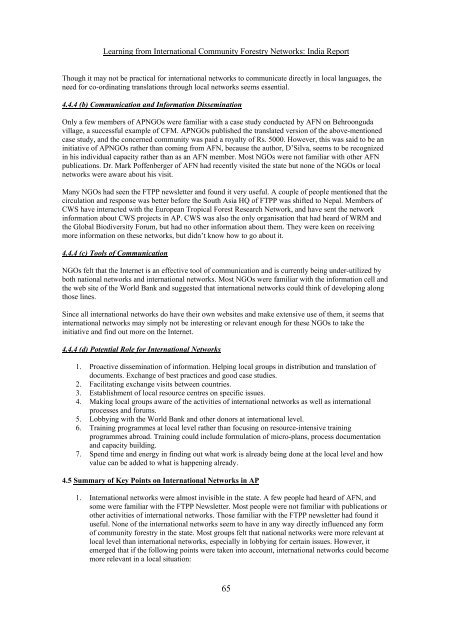Snapshots of International Community Forestry Networks: Country ...
Snapshots of International Community Forestry Networks: Country ...
Snapshots of International Community Forestry Networks: Country ...
You also want an ePaper? Increase the reach of your titles
YUMPU automatically turns print PDFs into web optimized ePapers that Google loves.
Learning from <strong>International</strong> <strong>Community</strong> <strong>Forestry</strong> <strong>Networks</strong>: India Report<br />
Though it may not be practical for international networks to communicate directly in local languages, the<br />
need for co-ordinating translations through local networks seems essential.<br />
4.4.4 (b) Communication and Information Dissemination<br />
Only a few members <strong>of</strong> APNGOs were familiar with a case study conducted by AFN on Behroonguda<br />
village, a successful example <strong>of</strong> CFM. APNGOs published the translated version <strong>of</strong> the above-mentioned<br />
case study, and the concerned community was paid a royalty <strong>of</strong> Rs. 5000. However, this was said to be an<br />
initiative <strong>of</strong> APNGOs rather than coming from AFN, because the author, D’Silva, seems to be recognized<br />
in his individual capacity rather than as an AFN member. Most NGOs were not familiar with other AFN<br />
publications. Dr. Mark P<strong>of</strong>fenberger <strong>of</strong> AFN had recently visited the state but none <strong>of</strong> the NGOs or local<br />
networks were aware about his visit.<br />
Many NGOs had seen the FTPP newsletter and found it very useful. A couple <strong>of</strong> people mentioned that the<br />
circulation and response was better before the South Asia HQ <strong>of</strong> FTPP was shifted to Nepal. Members <strong>of</strong><br />
CWS have interacted with the European Tropical Forest Research Network, and have sent the network<br />
information about CWS projects in AP. CWS was also the only organisation that had heard <strong>of</strong> WRM and<br />
the Global Biodiversity Forum, but had no other information about them. They were keen on receiving<br />
more information on these networks, but didn’t know how to go about it.<br />
4.4.4 (c) Tools <strong>of</strong> Communication<br />
NGOs felt that the Internet is an effective tool <strong>of</strong> communication and is currently being under-utilized by<br />
both national networks and international networks. Most NGOs were familiar with the information cell and<br />
the web site <strong>of</strong> the World Bank and suggested that international networks could think <strong>of</strong> developing along<br />
those lines.<br />
Since all international networks do have their own websites and make extensive use <strong>of</strong> them, it seems that<br />
international networks may simply not be interesting or relevant enough for these NGOs to take the<br />
initiative and find out more on the Internet.<br />
4.4.4 (d) Potential Role for <strong>International</strong> <strong>Networks</strong><br />
1. Proactive dissemination <strong>of</strong> information. Helping local groups in distribution and translation <strong>of</strong><br />
documents. Exchange <strong>of</strong> best practices and good case studies.<br />
2. Facilitating exchange visits between countries.<br />
3. Establishment <strong>of</strong> local resource centres on specific issues.<br />
4. Making local groups aware <strong>of</strong> the activities <strong>of</strong> international networks as well as international<br />
processes and forums.<br />
5. Lobbying with the World Bank and other donors at international level.<br />
6. Training programmes at local level rather than focusing on resource-intensive training<br />
programmes abroad. Training could include formulation <strong>of</strong> micro-plans, process documentation<br />
and capacity building.<br />
7. Spend time and energy in finding out what work is already being done at the local level and how<br />
value can be added to what is happening already.<br />
4.5 Summary <strong>of</strong> Key Points on <strong>International</strong> <strong>Networks</strong> in AP<br />
1. <strong>International</strong> networks were almost invisible in the state. A few people had heard <strong>of</strong> AFN, and<br />
some were familiar with the FTPP Newsletter. Most people were not familiar with publications or<br />
other activities <strong>of</strong> international networks. Those familiar with the FTPP newsletter had found it<br />
useful. None <strong>of</strong> the international networks seem to have in any way directly influenced any form<br />
<strong>of</strong> community forestry in the state. Most groups felt that national networks were more relevant at<br />
local level than international networks, especially in lobbying for certain issues. However, it<br />
emerged that if the following points were taken into account, international networks could become<br />
more relevant in a local situation:<br />
65

















![CynefinFramework final [Read-Only]](https://img.yumpu.com/19017304/1/190x135/cynefinframework-final-read-only.jpg?quality=85)